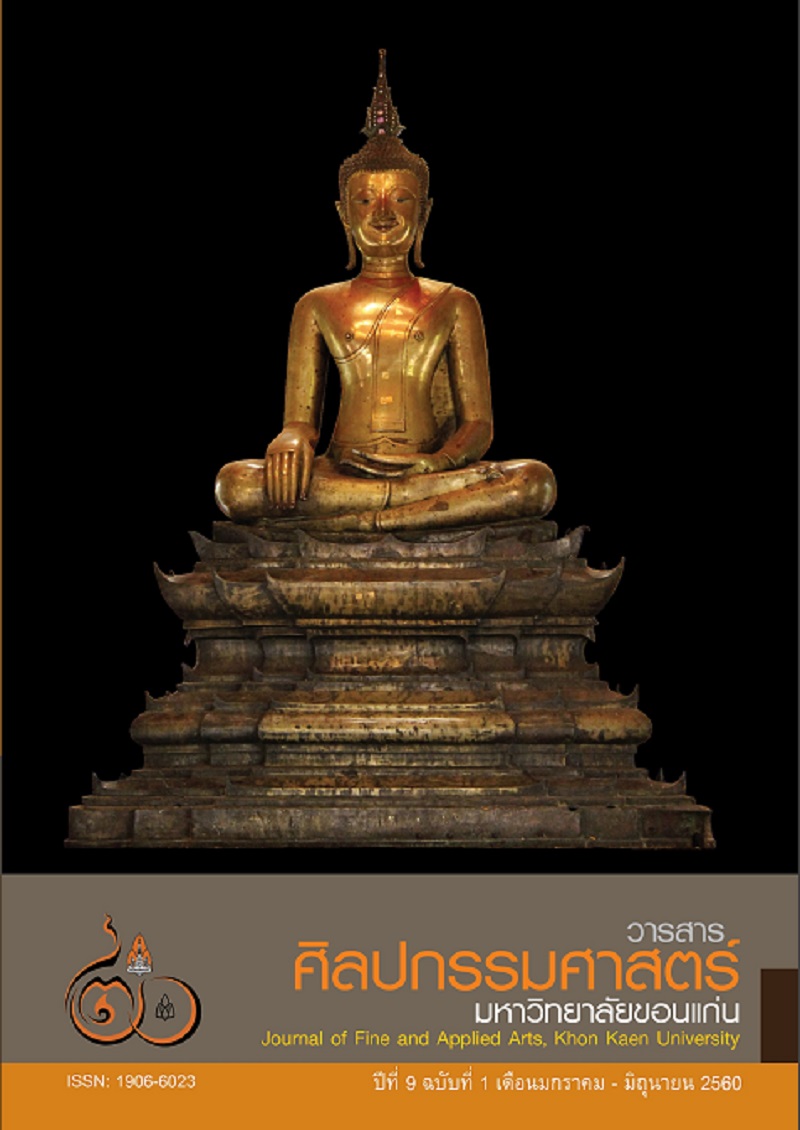รูปแบบทางศิลปะของพุทธปฏิมากรรมสำริดศิลปะล้านช้างในอีสาน The Lan Xang Art Forms of Bronze Buddhist Sculptures in Isaan
Main Article Content
Abstract
บทความเรื่องนี้เป็นส่วนหนึ่งของการวิจัยเรื่อง การศึกษาพุทธปฏิมากรรมสำริดศิลปะล้านช้างในอีสาน ซึ่งมีวัตถุประสงค์ เพื่อวิเคราะห์รูปแบบทางศิลปะของพุทธปฏิมากรรมสำริดศิลปะล้านช้างในอีสาน โดยใช้วิธีการวิจัยเชิงคุณภาพ ด้วยการบูรณาการวิธีการศึกษาตามเงื่อนไขและข้อมูลที่มีความแตกต่างกันดังนี้ วิธีการทางประวัติศาสตร์ศิลปะ การศึกษาภาคสนาม การศึกษาวิจัยเอกสาร เครื่องมือที่ใช้ในการวิจัย ได้แก่ แบบสำรวจ แบบสังเกต และแบบสัมภาษณ์ แล้วนำข้อมูลที่รวบรวมได้ทั้งหมดมาทำการวิเคราะห์และนำเสนอผลการวิจัยด้วยการพรรณนาวิเคราะห์ ประกอบภาพถ่าย จากการวิเคราะห์และจำแนกรูปแบบพุทธปฏิมากรรมสำริดศิลปะล้านช้างในอีสาน 3 แนวทาง คือ จากพุทธศิลป์ จากฝีมือเชิงช่างและจากการแสดงปาง ผลการวิจัยพบว่า พุทธปฏิมากรรมสำริดศิลปะล้านช้างในอีสานส่วนใหญ่ถูกเคลื่อนย้ายมาอยู่ในระหว่างสมัยศิลปะล้านช้างตอนต้นช่วงกลางถึงสมัยศิลปะล้านช้างตอนหลังช่วงปลาย จากพุทธศิลป์สามารถจำแนกได้ 5 กลุ่ม คือ อิทธิพลทางศิลปะสุโขทัย อิทธิพลทางศิลปะล้านนาอิทธิพลทางศิลปะอยุธยา ศิลปะล้านช้างบริสุทธิ์และอิทธิพลศิลปะรัตนโกสินทร์และรูปแบบพระพุทธปฏิมากรรมสำริดศิลปะล้านช้าง จากการวิเคราะห์ฝีมือเชิงช่างโดยใช้รูปทรง สัดส่วน ความละเอียดขององค์ประกอบอื่นขององค์พระ ซึ่งโดยภาพรวมแล้วสามารถแบ่งรูปแบบของพุทธปฏิมากรรมสำริดศิลปะล้านช้างในอีสานจากฝีมือเชิงช่างและสุนทรียภาพออกเป็น 2 กลุ่มใหญ่ คือ กลุ่มฝีมือช่างหลวงหรือช่างราชสำนักกับกลุ่มฝีมือช่างราษฏร์หรือช่างพื้นบ้าน และพุทธปฏิมากรรมสำริดศิลปะล้านช้างที่พบจำแนกการแสดงปางต่างๆได้ 11 ปาง ดังนี้ ปางมารวิชัย 396 องค์ ปางสมาธิ 26 องค์ ปางห้ามสมุทร 20 องค์ ปางห้ามญาติ 6 องค์ ปางทรงพิจารณาธรรม 2 องค์ ปางถวายเนตร 1 องค์ ปางยืน 6 องค์ ปางลีลา 1 องค์ ปางนาคปรก 2 องค์ พระสังกัจจายน์ 5 องค์และพระศรีอาริย์หรือพระสาวก 3 องค์
This article is part of the research on The Buddhist Bronze Sculptures Lan Xang Art in Isaan with the objectives to analyze the artistic form of the Bronze Buddhist sculptures Lan Xang Art in Isaan through qualitative research. This study is an integrated study according to the following different conditions and information: historical art methods, field study, and studying the documents. The research tools are questionnaire, observation forms, and interviews. The data collected were compiled, analyzed, and resented using descriptive analysis in combination with photos. As for the result of the study, from the analysis and the categorizations of the Lan Xang Buddhist sculpture forms in Isaan put the sculptures into three different sources: from Buddhist arts, from the work of the sculptors, and the postures of the Buddha images. It was found that most of the Buddhist sculptures were moved in during the beginning to the later period of the Lan Xang. This can be further categorized into 5 different types: Buddhist arts, which consist of the Sukhothai art influence, Lanna art influence, Ayutthaya art influence, pure Lan Xang art influence, and Rattanakosin art influence. From the analysis of the Lan Xang art according to the style of that the sculptors used, the shapes, and the detail of the rest of the sculptors, the bronze Buddhist sculptures can be categorized into 2 types which are the sculptures done by the royal sculptors or sculptors from the palace and the local sculptors or the sculptors from outside of the palace. The Lan Xang bronze Buddhist sculptures can also be categorized into 11 types according to their postures: 396 Bhumisparsa mudra posture, 26 Dhyana postures, 20 Preventing calamities postures, 6 preventing quarrel posture, 2 in pensive thoughts posture, 1 gazing at Bodhi tree posture, 6 standing postures, 1 walking posture, 2 Buddha shelter by Naga posture, 5 smiling Buddha and 3 images of the disciples.
Article Details
Content and information in articles published in the Journal of Fine and Applied Arts of Khon Kaen University is regarded as the opinion and sole responsibility of the author(s) directly; therefore, editors are not obliged to agree to or share any responsibility with regard to the content and information that appears within these articles.
All articles, information, content, image, etc. that have been published in the Journal of Fine and Applied Arts of Khon Kaen University is the copyright of the Journal of Fine and Appllied Arts of Khon Kaen University. Any person or organization who wishes to distribute all or parts of the articles for further dissemination or other usage must first receive permission from the Journal of Fine and Applied Arts of Khon Kaen University before proceeding to do so.

